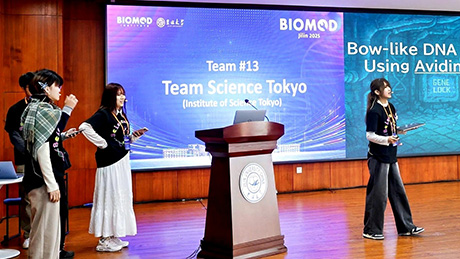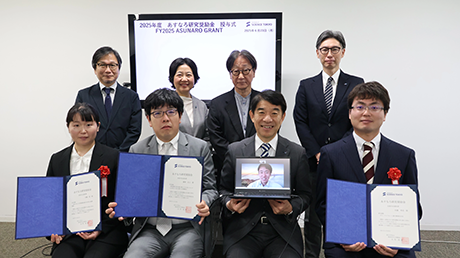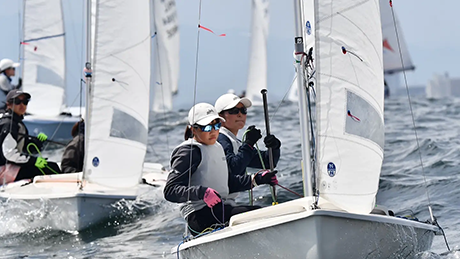Life Science and Technology News
Nobel Week Part 2:December 9-12, 2016
The week surrounding December 10, the anniversary of Alfred Nobel's death, is studded with various events held in and around Stockholm to celebrate the awarding of the Nobel Prizes. This period between December 6 and 12 is known as Nobel Week. President Yoshinao Mishima and other members of Tokyo Tech travelled to Sweden to accompany Honorary Professor Yoshinori Ohsumi, the winner of the Nobel Prize in Physiology or Medicine, for this year's Nobel Week.
For details of the first half of Nobel Week, read Part 1 of the journal.
December 9
Ohsumi and his wife, Dr. Mariko Ohsumi, began the fourth day of Nobel Week with a relaxing breakfast at the Grand Hôtel, occasionally exchanging words with acquaintances who visited their table.
Mishima's morning started with a visit to the Nobel Museum. He bore a gift — a bottle of Japanese sake with an illustration of autophagy printed on its label — that Ohsumi had been unable to bring to the museum on the previous day. The museum director was unfortunately absent, but a member of the museum staff acted on his behalf and graciously accepted the gift.

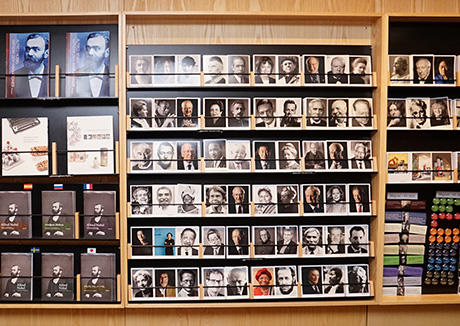
After returning to the hotel, it was time to give an interview to the Japan Broadcasting Corporation. Mishima spoke to the reporter about how the award had prompted Tokyo Tech to consider ways of supporting and encouraging young researchers to follow in the footsteps of Ohsumi.
In the evening, Ohsumi attended a reception at the Nordic Museum, hosted jointly by the Nobel Foundation and the Royal Swedish Academy of Sciences. Showing no sign of fatigue, Ohsumi enjoyed the splendor of the evening.
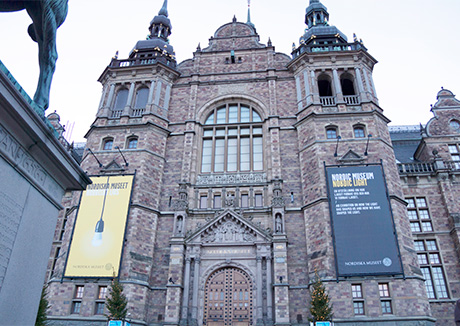


Ohsumi with other guests
December 10
This was the big day when the Nobel Prize Award Ceremony and Nobel Banquet were to be held.
Ohsumi spent the morning taking part in a rehearsal for the awards ceremony at the Stockholm Concert Hall. Snow clouded the city that day, but that did not seem to dampen Ohsumi's spirits, and he appeared quite at ease.
In the afternoon, guests began making their way to the Grand Hôtel lobby. Donned in white ties and dresses, they waited for coaches that would transport them to the venue. Mishima and Kazuya Masu, director-general of Tokyo Tech's Institute of Innovative Research (IIR), were among them. After the guests departed, it was Ohsumi and his wife's turn to get into their limousine bound for the Stockholm Concert Hall.

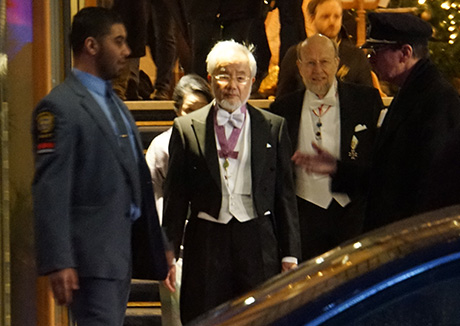

Nobel Prize Award Ceremony
© Nobel Media AB 2016. Photo: Pi Frisk
The start of the awards ceremony was marked by the entrance of Sweden's Royal Family on stage, where Nobel judges and members of prize-awarding institutions were waiting. There was a subsequent performance of the Swedish royal anthem, and then, led by Mozart's march, a procession of this year's Nobel laureates took center stage. Ohsumi was wearing the Cultural Medal awarded to him in November.
After an opening address by the Chairman of the Board of the Nobel Foundation came the presentation of the Nobel Prizes. The Nobel Prize in Physics was awarded first, followed by Chemistry, and then Physiology or Medicine. A speech in Swedish was delivered by a Nobel Committee member on Ohsumi's achievements on autophagy, and following that, he was called to step forward to receive his prize from King Carl XVI Gustaf of Sweden. Ohsumi accepted his medal and diploma firmly with one hand, shaking the king's hand with the other. What thoughts must have gone through his mind at that moment.

Ohsumi receiving medal and diploma from King Carl XVI Gustaf of Sweden
© Nobel Media AB 2016. Photo: Pi Frisk
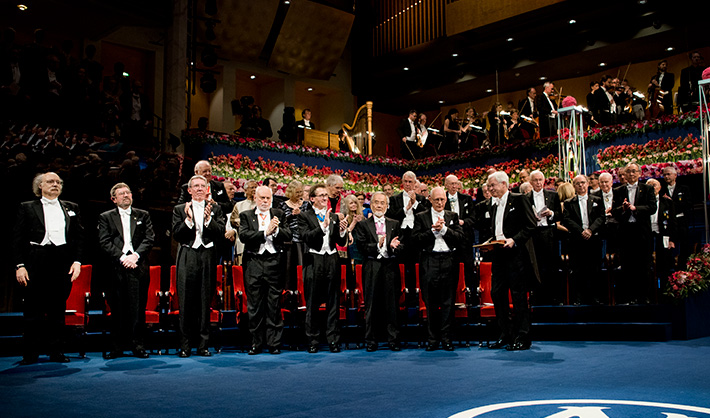
Nobel laureates at awards ceremony.
From left: Physics laureates F. Duncan, M. Haldane, and J. Michael Kosterlitz;
Chemistry laureates Jean-Pierre Sauvage, Sir J. Fraser Stoddart, and Bernard L. Feringa;
Medicine laureate Yoshinori Ohsumi; Economic Sciences laureates Oliver Hart and Bengt Holmström
© Nobel Media AB 2016. Photo: Alexander Mahmoud

Ohsumi after receiving his Nobel Prize
© Nobel Media AB 2016. Photo: Pi Frisk
Patti Smith attended the awards ceremony on behalf of Bob Dylan, who won the Nobel Prize in Literature. She gave a moving rendition of A Hard Rain's A-Gonna Fall accompanied by guitar and orchestra. Finally, the Prize in Economic Sciences was presented, and the dignified, hour-and-a-quarter-long ceremony drew to a close with the Swedish national anthem performed by the orchestra.

Tokyo Tech delegation with Patti Smith at Grand Hôtel
A banquet at Stockholm City Hall followed soon after the awards ceremony.
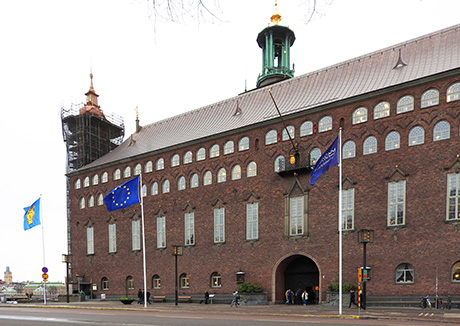
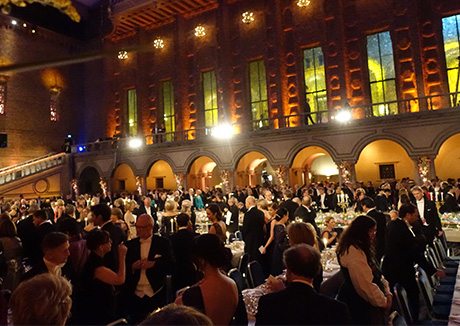
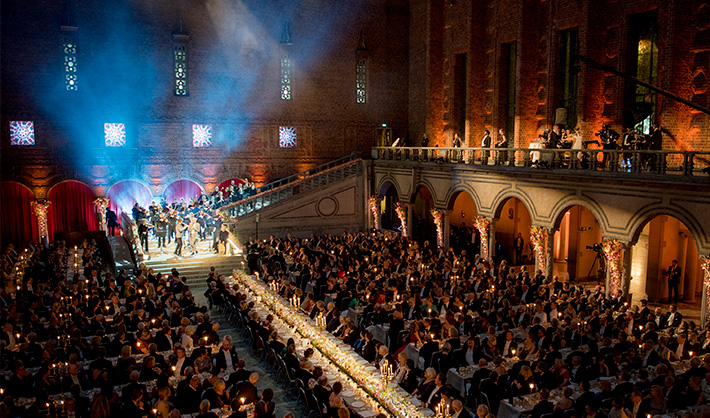
Clarinetist, flutist, orchestra entertaining the guests
© Nobel Media AB 2016. Photo: Alexander Mahmoud
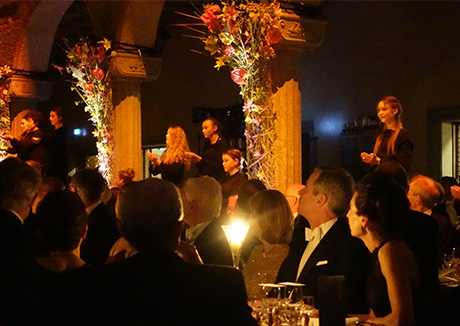
Guests listening to choral music
The resounding trumpet fanfare in the Blue Hall announced the entrance procession of the Swedish Royal Family, Nobel laureates, and other guests of honor, who descended the grand staircase decked with flowers. Once they were seated at the Table of Honor, the Chairman of the Board of the Nobel Foundation offered a toast to King Carl XVI Gustaf of Sweden, who then responded with a toast to Alfred Nobel. With this, conversations among guests began to flow and dinner was served. The banquet was enlivened with a series of divertissements that included dance, hymns, and orchestral music entwined with a dialog between a clarinetist and flutist.
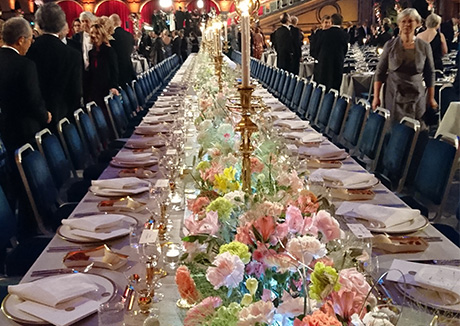
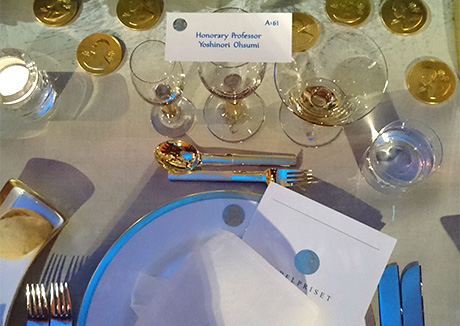
There was time for thank-you speeches by the laureates as well. When Ohsumi's turn to speak came, the evening's toastmaster introduced him in Swedish, Japanese, and English. From the lectern set up on the staircase landing, Ohsumi drew laughter from the guests by saying how much he benefited from yeast, including his enjoyment of sake and other alcoholic beverages. He also alluded to the prospects of future autophagy research and ended his speech by thanking his collaborators and family for all the support they had given him over the years.
The banquet, in celebration of the Nobel laureates' achievements, was attended by 1,300 guests that included Mishima as well as Ohsumi's research collaborators. The meticulously prepared dinner and entertainment were enjoyed by all who attended.
Note:
1. For Ohsumi's banquet speech![]() , go to the Nobel Foundation's website.
, go to the Nobel Foundation's website.
2. For details of the awards ceremony and banquet, see "Professor Ohsumi Attends Nobel Prize Award Ceremony and Banquet.![]() "
"
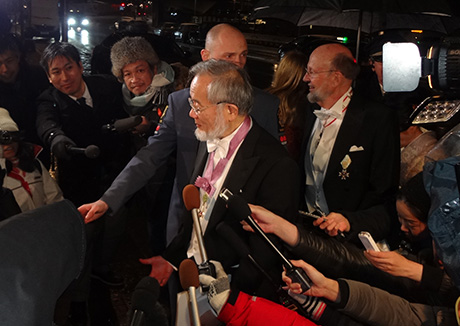
Back at hotel
When Ohsumi finally returned to the Grand Hôtel, it was already half past eleven. He looked glad to have completed the long, momentous day.
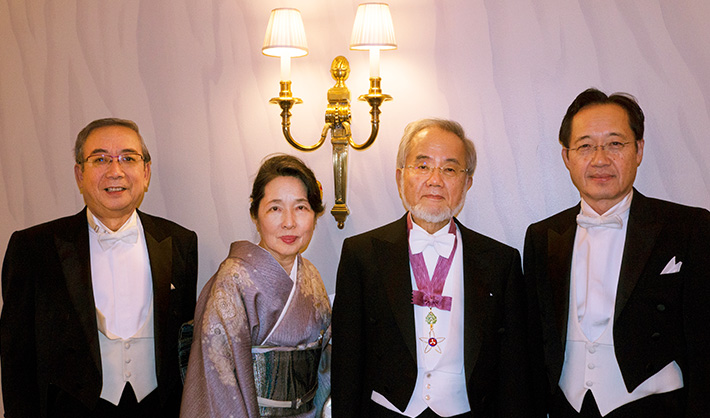
From left: Mishima, Mariko Ohsumi, Yoshinori Ohsumi, Masu
December 11
Ohsumi spent the day following the awards ceremony and banquet busily carrying out engagements. First, he spent the early morning giving press interviews.
Next, he visited a Japanese school in Stockholm where he talked to the children about the importance of maintaining curiosity. He presented an autograph with the following message: "The joy of learning comes from keen observation."

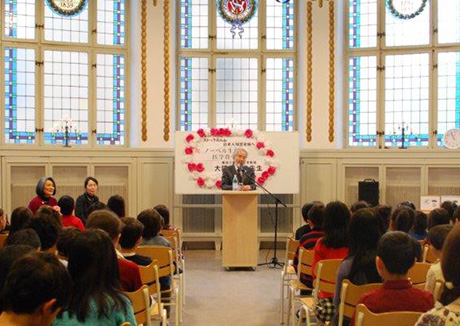
Ohsumi giving talk at Japanese school in Stockholm

Luncheon hosted by Minister of Education, Culture, Sports, Science and Technology (right)
Ohsumi, together with his wife, then attended a luncheon hosted by Hirokazu Matsuno, Japan's Minister of Education, Culture, Sports, Science and Technology. Mariko Ohsumi's words during the event were particularly poignant. She explained how her husband's life in research was never plain sailing, and that there was a time when his parents became very worried. Although his parents did see Ohsumi's research get on track before passing away, she still found the awards ceremony highly emotive, knowing how proud they would have been had they witnessed the event.
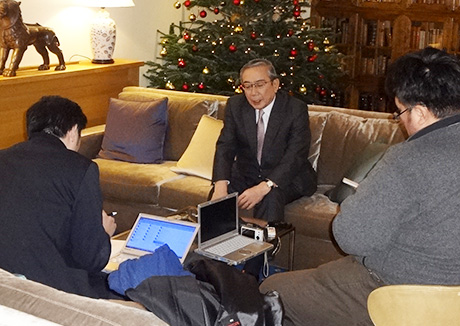
Mishima giving interview
Mishima spent the afternoon talking to the press. He told reporters how, in response to Ohsumi's call for greater support for young researchers, Tokyo Tech was considering setting up a tentatively named Ohsumi Fund through its funding framework.
A Royal Banquet Dinner awaited Ohsumi in the evening. Clad in white tie and a kimono once again, Ohsumi and his wife were whisked off in their limousine to the Royal Palace.

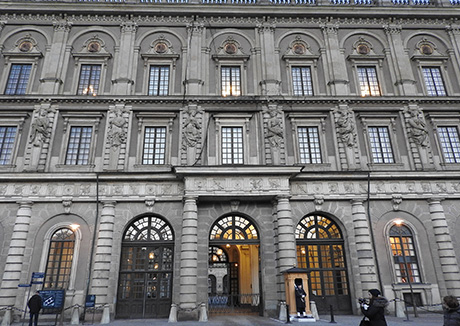
December 12
The last day of Nobel Week was tightly packed with engagements for Ohsumi.
The early part of the morning was spent giving interviews, where he spoke of his wish to set up a fund for young researchers. Following that, he visited the Nobel Foundation to retrieve the Nobel diploma and medal.
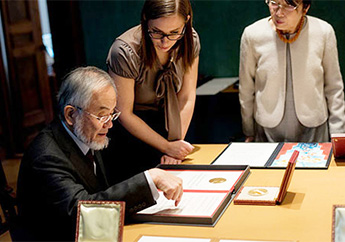
© Nobel Media AB 2016. Photo: Alexander Mahmoud
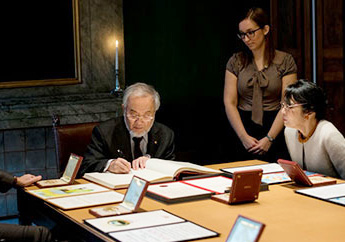
Ohsumi signing the Nobel Foundation's guest book that includes signatures of Nobel laureates since 1952
© Nobel Media AB 2016 Photo: Alexander Mahmoud
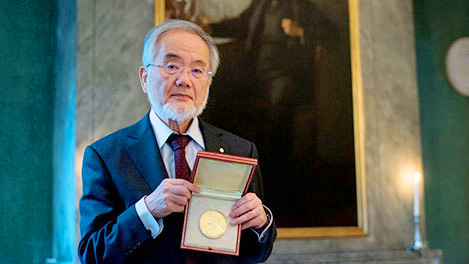
Ohsumi holding his medal at the Nobel Foundation
© Nobel Media AB 2016. Photo: Alexander Mahmoud
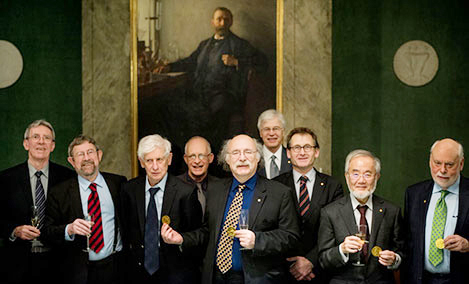
Nobel laureates 2016 at the Nobel Foundation
From left: Jean-Pierre Sauvage, J. Michael Kosterlitz, David J. Thouless, Oliver Hart, F. Duncan M. Haldane, Bengt Holmström, Bernard L. Feringa, Yoshinori Ohsumi, and Sir J. Fraser Stoddart
© Nobel Media AB 2016. Photo: Pi Alexander Mahmoud
Mishima used his morning to pay homage at the grave of Alfred Nobel in Stockholm. The cemetery was covered in white snow and Mishima had to trudge his way to Nobel's headstone, where he expressed his gratitude for Ohsumi's award.
Following that, he was to meet Tokyo Tech students on a study abroad program at the Royal Institute of Technology of Sweden. Kozuka and Kanamori, first year master's students majoring in Mechanical Engineering and Life Science and Technology respectively, had been in Sweden since summer and had many tales to tell about studying abroad.
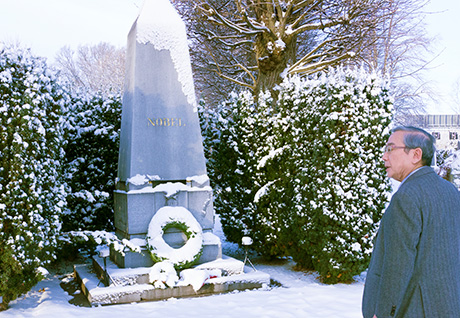
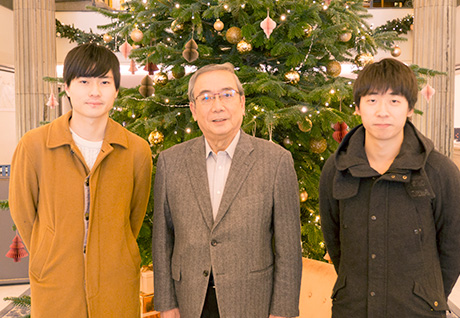
Mishima with Kozuka (left) and Kanamori (right)
At midday, Ohsumi had lunch with the Pro-Vice-Chancellor of the Karolinska Institute. When the evening came, he visited the Nobel Foundation once again to attend a reception that was to be his last formal event in Sweden.
What seemed like an interminable week was finally over. It must have been the intensity of the marathon of events that led Ohsumi to question how many days he had actually spent in Sweden. Many of the guests at the Grand Hôtel were now leaving.
The only task remaining for Tokyo Tech staff who accompanied Ohsumi was to make one final visit to Ms. Sofia at the Nobel Desk to thank her for all the hospitality they had received.
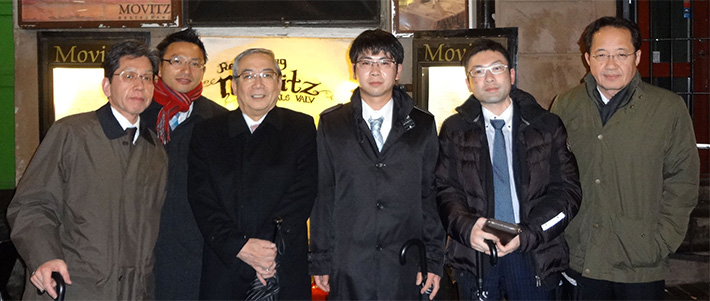
Contributors to Nobel Week Report. From left: Hirokazu Kurosawa, director of General Affairs; Toshiaki Mizuno, director of International Affairs; Yoshinao Mishima, president; Hisatoshi Hasegawa, International Student Exchange Division staff; Yoshitsugu Kobayashi, secretarial officer at General Affairs Division; Kazuya Masu, director-general of IIR
Note: For details of the press conference Ohsumi and his wife gave on their return to Japan at Haneda Airport, read the Proceedings of Press Conference Held on Return from Stockholm![]() (Japanese).
(Japanese).
Learn more about Honorary Professor Yoshinori Ohsumi and his prize-winning research into the mechanisms of autophagy
Special webpage for 2016 Nobel laureate in Physiology or Medicine![]()
Contact
Center for Public Affairs and Communications
Email nobel@jim.titech.ac.jp
Tel +81-3-5734-2975



